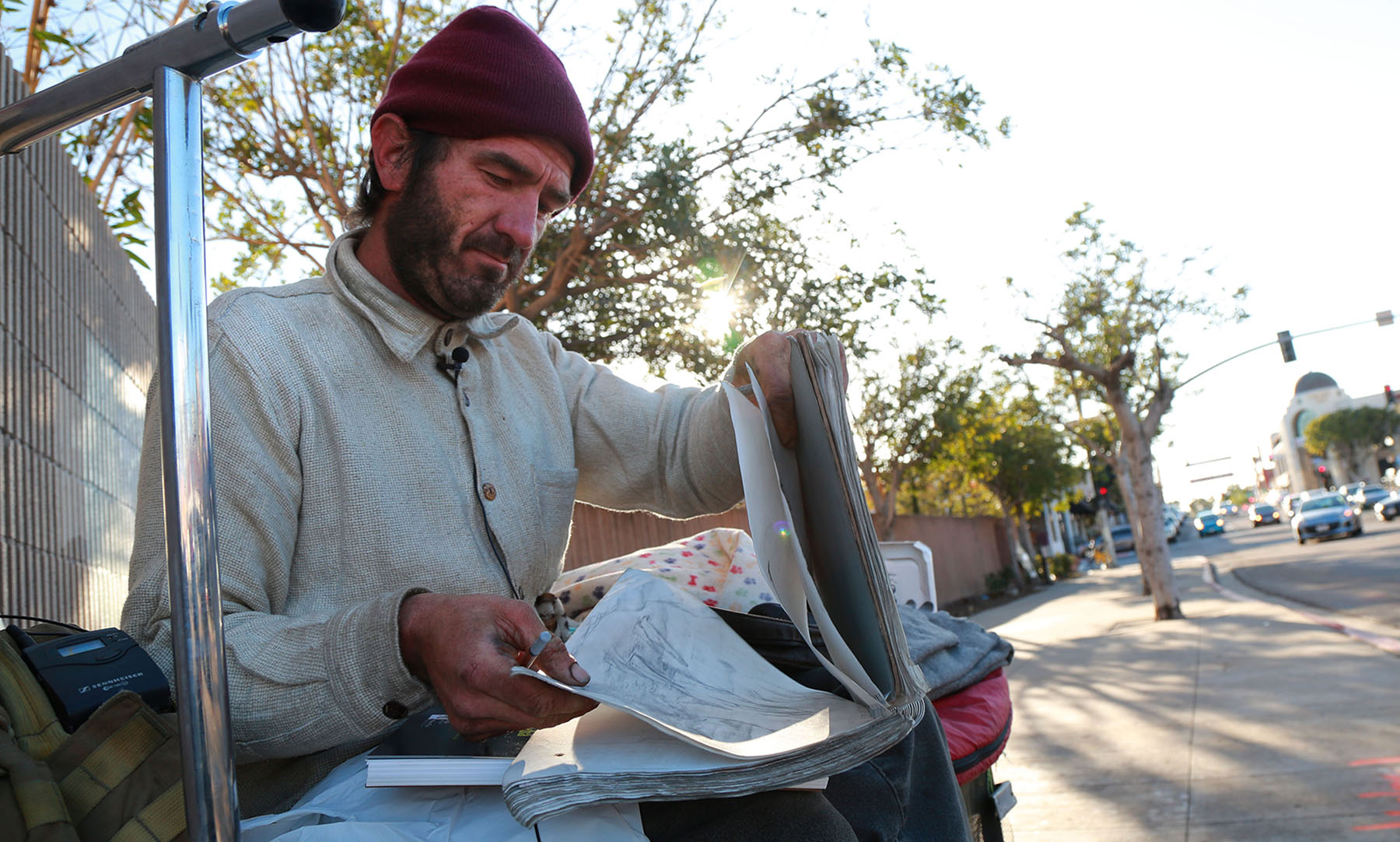Mark Hicks
Mark Hicks, 36, was born in Slab City. His mother went into labor while they were living in the iconoclastic desert community. By the time the ambulance arrived, Hicks was already presenting himself to the world.
His father, brother, niece, nephew and sister-in-law still live there. But Mark wasn’t fond of the heat, nor the persistent hunger that plagued his childhood years. Fonder memories of the family living in San Diego for a few years when he was 17-19 lingered in the back of his mind, so when he finally decided to head out on his own, Hicks came west.
In 2010 he met his partner, and they lived together happily in the Hillcrest area till his partner died in June of 2016. Mark learned to paint in 2011. He was a natural and spent much of his time painting and caring for their home. His artwork improved quickly, and he was able to sell some paintings. But when his partner died, his partner’s sister took everything, including Hick’s art supplies, and tossed him to the curb. He has been homeless ever since.
After a significant grieving period, Hicks came to the understanding he needs to do something with his life. He’d like to get indoors, find a job where he can work with his hands, maybe teach art. But he knows the odds are stacked against him. He cited people who are not homeless, with degrees and concrete skills, who have trouble finding work in San Diego. “You name me one employer that will hire me if I walk in with my cart.”
Hicks thinks the city and agencies like Father Joe’s shouldn’t be given any more money by the state or the federal government to assist the homeless because they are failing miserably. “If you put people in a dorm situation all you’ll get is thieving. I can get that on the street. Why should I move into a situation where it’s concentrated? And every time you open up one of these shelters, and you've got canines and people in police uniforms…you might as well be in prison!”
What needs to happen, Hicks said, is building more SROs downtown. Being able to have your own place, albeit a small one, allows a person to feel like they are in control of their own lives, which motivates them to improve their situation all around. That needs to be followed by rent control, he said, so those SROs don’t become gentrified condominiums.
He has social anxiety. He doesn’t like being around crowds, and therefore stays away from downtown even though that’s where the food hand-outs are. He spent the last two days without food as a result. Hicks survives on EBT money, $195/month, which, when you consider homeless people can’t cook fresh food or store perishable items like milk or meat, that money goes to fast food, and it only lasts 10-14 days even if you’re careful.
Hicks is hoping to win a lottery slot at the Balboa Park museums that allows artists and buskers to set up in the park doing what they do for a whole month without having to pay for that privilege, and not being harassed by park rangers to move along. “It’s a place for people like me to display their talents and for people to get to see them, you know? I’m hoping to get to be able to do that next month.” He would have a whole portfolio of work to show except his sketchbook was recently stolen along with his backpack.
His pug mix dog Doogie, 7, was part of the family when Hicks’ partner was alive. So she represents some of those good memories of the whole family together. He keeps her wrapped in a blanket decorated with prints of colorful dog biscuits. Most people on the street take better care of their animals than they do themselves, he noted. So when he goes hungry, Hicks makes sure Doogie does not.
There are countless stereotypes about homeless people that Hicks wishes he could dispel. “They’re not all lazy. They’re not all drug addicts. You’ve got to take homeless people individually, just like you do a person who lives indoors.” he said. “You’d be surprised how many people walk by you every day that’s homeless and you don’t even know it… We’ve got substitute teachers out here…. When a person works three jobs and they still can’t afford to rent a place, what can they do? They become homeless.”
Citing the recent laws passed in El Cajon against feeding the homeless, Hicks feels the city of San Diego and El Cajon ought to be sued for crimes against humanity. “How can it be against the law to feed another person?” he asked. Shaking his head about that infraction, he added how sad it is that people don’t even say hello to each other any more. He gets angry when he smiles and nods to passersby and people just walk by or stare at him. “But you can’t stay angry too long or your life’s miserable, right?” he asked rhetorically.
When he needs to deal with anger, or just let his emotions out, Hicks turns his attention to his drawings, making deep waterfalls and rocky shorelines, tall mountains and flowering trees. Then his eraser changes everything, and he starts over. “Art’s like my escape, and that’s why I continue doing art.”




